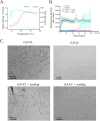A mouse model of cardiac immunoglobulin light chain amyloidosis reveals insights into tissue accumulation and toxicity of amyloid fibrils
- PMID: 40148271
- PMCID: PMC11950232
- DOI: 10.1038/s41467-025-58307-2
A mouse model of cardiac immunoglobulin light chain amyloidosis reveals insights into tissue accumulation and toxicity of amyloid fibrils
Abstract
Immunoglobulin light chain (LC) amyloidosis (AL) is one of the most common types of systemic amyloidosis but there is no reliable in vivo model for better understanding this disease. Here, we develop a transgenic mouse model producing a human AL LC. We show that the soluble full length LC is not toxic but a single injection of pre-formed amyloid fibrils or an unstable fragment of the LC leads to systemic amyloid deposits associated with early cardiac dysfunction. AL fibrils in mice are highly similar to that of human, arguing for a conserved mechanism of amyloid fibrils formation. Overall, this transgenic mice closely reproduces human cardiac AL amyloidosis and shows that a partial degradation of the LC is likely to initiate the formation of amyloid fibrils in vivo, which in turn leads to cardiac dysfunction. This is a valuable model for research on AL amyloidosis and preclinical evaluation of new therapies.
© 2025. The Author(s).
Conflict of interest statement
Competing interests: The authors declare no competing interests.
Figures







References
-
- Merlini, G. & Stone, M. J. Dangerous small B-cell clones. Blood108, 2520–2530 (2006). - PubMed
-
- Sanchorawala, V. Systemic light chain amyloidosis. N. Engl. J. Med.390, 2295–2307 (2024). - PubMed
-
- Comenzo, R. L., Zhang, Y., Martinez, C., Osman, K. & Herrera, G. A. The tropism of organ involvement in primary systemic amyloidosis: contributions of Ig V(L) germ line gene use and clonal plasma cell burden. Blood98, 714–720 (2001). - PubMed
MeSH terms
Substances
Grants and funding
- FRM-EQU202203014615/Fondation pour la Recherche Médicale (Foundation for Medical Research in France)
- n.a/Ligue Contre le Cancer
- n.a/Conseil Régional Aquitaine (Aquitaine Regional Council)
- n.a/Fondation ARC pour la Recherche sur le Cancer (ARC Foundation for Cancer Research)
- EH 100/21-1/Deutsche Forschungsgemeinschaft (German Research Foundation)
LinkOut - more resources
Full Text Sources
Medical
Molecular Biology Databases

